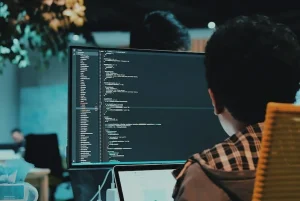Creating games isn’t just exciting for kids; it’s also an incredibly powerful way to learn. By building their own games, children get to combine imagination with logic, storytelling with technology, and play with problem-solving. Whether they’re guiding a cat through a maze or building a simple quiz, the process encourages creativity, critical thinking, and persistence.
Visual programming platforms like Scratch make this learning journey accessible and enjoyable. Instead of typing complex code, kids use colorful blocks that snap together, allowing them to focus on how things work without getting stuck on syntax. Scratch was designed specifically for young learners, typically between ages 6 and 16, and is now used by millions of children around the world in schools, coding clubs, and at home.
Looking for the best way to introduce coding for kids? Enroll your child in our Scratch Game Development Bootcamp at All Things Programming, where young creators explore coding for kids, turn their ideas into games, and build real tech confidence in a fun, hands-on environment.
With just a computer and curiosity, kids can turn their ideas into interactive games and learn the foundations of real programming along the way.
What Is Scratch?
Scratch is a beginner-friendly programming language created by MIT to help kids learn how to code in a fun, visual way. Instead of writing lines of text like professional programmers, children use a drag-and-drop interface to snap together colorful blocks that represent code instructions.
This approach removes the frustration of syntax errors and lets kids focus on building logic, solving problems, and expressing creativity. They can animate characters, create stories, build games, and even make interactive quizzes, all while learning the basics of coding.
Scratch is designed especially for young learners, typically ages 6 to 16, and is used in schools, homes, and coding clubs around the world. One of its best features is its vibrant online community, where kids can share their projects, explore games made by others, and even remix existing creations. This community helps build collaboration, inspiration, and confidence as kids grow their coding skills.
Why Kids Should Try Building a Game
Building a game with Scratch isn’t just fun, it’s a powerful learning experience that blends play with real-world skills. When kids create their own games, they’re not just playing, they’re thinking like designers, storytellers, and problem-solvers.
Here’s what they gain from the process:
- Creativity & Problem-Solving: From designing characters to planning game rules, kids stretch their imagination and figure out how to make their ideas work.
- Logical Thinking & Sequencing: Coding a game teaches them to think in steps, what happens first, next, and under what conditions, building strong logic and math-related skills.
- Storytelling & Design: Kids learn how to craft engaging experiences by creating characters, choosing backdrops, and shaping the flow of the game.
- Confidence & Ownership: Seeing their game come to life and sharing it with friends or family gives kids a real sense of accomplishment and motivates them to keep learning.
At the heart of Coding Kenya, creating games with Scratch transforms kids from tech users into digital creators. We believe in empowering every child to become a problem-solver, innovator, and storyteller, not just in the classroom, but in the real world.
What You Need to Get Started
Getting started with Scratch is simple and budget-friendly, perfect for kids learning at home or in school. Here’s what you’ll need to begin your game-making adventure:
- A Device with Internet Access
A laptop, desktop computer, or tablet with an internet connection is all you need to access the Scratch platform. - A Free Scratch Account
Visit scratch.mit.edu to sign up for a free account. This lets kids save their work, share projects, and explore games made by other creators in the Scratch community. - Optional Extras
- A notebook for sketching out game ideas, characters, or levels
- Parent or teacher guidance, especially for younger kids who are just starting out
- Headphones or speakers for working with sound effects and music
With these basics, your child is ready to explore, create, and start coding their first game!
Brainstorming the Game Idea
Before jumping into Scratch, it helps to plan out the game. This step sparks creativity and gives kids a clear direction as they begin building.
Start with a Simple Game Type:
Choose a game that’s fun and easy to make. Here are a few great first-time options:
- Catch-the-object (e.g., catch falling apples)
- Maze game (guide a sprite to the goal)
- Quiz game (answer questions correctly)
- Platformer (jump from platform to platform)
Define the Key Elements:
- Characters (Sprites): Who is the player controlling? What other characters are in the game?
- Setting (Backdrop): Where does the game take place, in a forest, outer space, or a classroom?
- Game Goal: What does the player need to do to win? Collect points? Reach the end? Avoid enemies?
Keep It Simple at First:
Kids don’t need fancy graphics or complicated mechanics for their first project. A simple idea done well is more rewarding and easier to finish than something too ambitious.
Step-by-Step: Building the Game
Now it’s time for the fun part: creating your game in Scratch! Follow these simple steps to bring your idea to life:
a. Create or Choose Sprites
Sprites are the characters or objects in your game.
- You can pick from Scratch’s built-in sprite library
- Or draw your own using the built-in paint editor
- You can even upload images if you want something custom
b. Design the Backdrop
Set the stage for your game.
- Choose a backdrop from the Scratch library or design your own
- Think about where your game takes place, a jungle, space, school, etc.
c. Add Movement
Make your sprite move using motion blocks.
- Use when key pressed to control the character with arrow keys
- Example: when right arrow pressed → move 10 steps
- Try out jumping, gliding, or bouncing too!
d. Add Game Logic
This is how you make your game work.
- Use blocks like if…then, touching, broadcast, and change score
- Example: if touching apple – change score by 1
- Add win or lose rules (like reaching a finish line or hitting an obstacle)
e. Add Sounds and Effects
Make your game more exciting with sound!
- Scratch has built-in sound effects like “pop”, “meow”, or music clips
- Play a sound when something is collected, clicked, or when the game ends
f. Test and Debug
Even pros make mistakes, that’s part of learning!
- Play your game to check if everything works
- Fix anything that doesn’t behave right (this is called “debugging”)
- Ask a friend or parent to test your game and give feedback
By following these steps, you’ll go from a blank screen to a playable game, all created by you!
Sharing the Game
Once the game is ready, it’s time to show it off! Scratch makes it easy for kids to share their creations and become part of a global community of young coders.
- Save and Publish:
Click the “Share” button on Scratch to publish your game so others can play it. Give your project a fun title and short description. - Share the Link:
Every project has its own unique URL. Copy the link and send it to friends, family, teachers, or classmates, they can play it right in their browser! - Explore and Remix:
Kids can also explore games made by other creators on scratch.mit.edu. If they find something inspiring, they can click “Remix” to make their own version, a great way to learn new skills and get ideas.
Sharing helps kids feel proud of what they’ve built and encourages them to keep coding, exploring, and improving.
What’s Next?
Finishing your first game is just the beginning! Once kids see what they can create with Scratch, there are endless ways to keep growing their skills and creativity.
- Add New Features
Make your game even better by:- Adding new levels or challenges
- Creating a score system or timer
- Introducing more characters (sprites) or power-ups
- Try Scratch Challenges
Join community challenges on scratch.mit.edu where kids build themed games or animations, a fun way to stay inspired and learn from others. - Explore Advanced Concepts
Ready for more? Try using:- Variables to track scores, health, or time
- Timers for countdowns or racing games
- Clones to create multiple enemies, objects, or effects
- Join a Coding Club
Look for local or online coding clubs where kids can meet other creators, share ideas, and work on projects together.
With every new game, kids strengthen their creativity, logic, and confidence, all while having fun. Keep exploring, keep coding, and remember: every expert was once a beginner!
Conclusion
Creating a first game with Scratch is a big achievement, so take a moment to celebrate your child’s creativity and effort! Whether it’s a simple maze or a fun catch-the-object game, they’ve taken their first real steps into the world of coding.
Remind them that learning to code is a journey, not something that needs to be perfect on the first try. Each game they build helps them think more creatively, solve problems more confidently, and bring their ideas to life in exciting new ways.
Most importantly, keep the spark alive. Encourage your child to stay curious, keep experimenting, and continue exploring what’s possible with code. Who knows, today’s simple Scratch game might be the start of tomorrow’s tech career!
Ready to take it further? Enroll them in our Coding for Beginners program at All Things Programming and turn curiosity into real skills, step by step, game by game.




